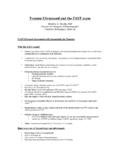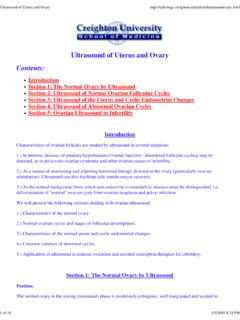Transcription of Ultrasound System Considerations and their …
1 Ultrasound System Considerations and their impact on Front-End Components Eberhard Brunner analog devices , Inc. 2002 Introduction Medical Ultrasound machines are some of the most sophisticated signal processing machines in use today. As in any machine there are many trade-offs in implementations due to performance requirements, physics, and cost. This paper will try to show the trade-offs for Ultrasound front-end circuits by starting from a high-level System overview followed by a more detailed description of how Ultrasound systems work. Some System level understanding is necessary to fully appreciate the desired front-end integrated circuit (IC) functions and performance, especially for: the Low Noise Amplifier (LNA); Time Gain Control (TGC); and A/D Converters (ADC).
2 Front-end is defined in this paper as all circuitry including the beamformers, even though the primary focus is on the analog signal processing components up to and including the ADCs. The main motivation for the author to write this paper was that most books and publications focus on the System level aspects of Ultrasound since they are written by System designers, but those don t explain what the effects of parameters in the front-end circuit components are on diagnostic performance. For a semiconductor company to provide optimal components though, it is essential for the IC designer to know what specifications are of particular importance and what effect they will have. Additionally there are trade-offs in terms of integration and semiconductor process technology that will force certain choices; these in turn are important for the Ultrasound System designer to know so that he can achieve the most advantageous System partitioning.
3 System Introduction In Ultrasound front-ends, as in many other sophisticated electronic systems, the analog signal processing components are key in determining the overall System performance. The front-end components define the bottleneck to System performance; once noise and distortion have been introduced it is essentially impossible to remove them. This is, of course, a general problem in any receive signal processing chain, be it Ultrasound or wireless. It is interesting to note that Ultrasound is really very similar to a radar or sonar System - radar works in the GHz range, sonar in the kHz range, and Ultrasound in the MHz range - but the System principals are essentially the same. Actually, an advanced Ultrasound System is practically identical to a Synthetic Array Radar (SAR).
4 Originally the phased array idea of steerable beams has been conceived by radar designers, however, Ultrasound designers expanded on the principle and today those systems are some of the most sophisticated signal processing equipment around. -1- HTX CW ( analog ) BeamformerTime Gain CompensationTGC -Beamformer Central Control SystemColor Doppler (PW )Processing (F Mode) Image &MotionProcessing (B Mode)SpectralDopplerProcessing(D Mode)Rx Beamformer (B & F Mode) TGCsLNAsTx BeamformerT/RSwitchesHV MUX/ DEMUX Cable One of the most expensive items! Transducer Display AudioOutputVAMPsFigure 1. Ultrasound System Block Diagram Figure 1 shows a simplified diagram of an Ultrasound System . In all systems there is a transducer at the end of a relatively long cable (ca.)
5 2m). This cable has from a minimum of 48 up to 256 micro-coaxial cables and is one of the most expensive parts of the System ; today there is ongoing research into 3-D Ultrasound for which even 512 cables and higher are being investigated. In practically all systems the transducer elements directly drive the cable which can result in significant signal loss due to the loading of the cable capacitance on the transducer elements; this in turn demands that the receiver noise figure (NF) is lower by the amount of the cable loss. One can expect a loss on the order of 1-3 dB depending on transducer and operating frequency. In most systems multiple probe heads can be connected to the System , this allows the operator to select the appropriate transducer for optimal imaging.
6 The heads are selected via High Voltage (HV) relays; these relays introduce large parasitic capacitance in addition to the cable. A HV Mux/Demux is used in some arrays to reduce the complexity of transmit and receive hardware at the expense of flexibility. The most flexible systems are Phased Array DBF systems where ALL transducer elements can be individually phase and amplitude controlled, these tend to be the most costly systems due to the need for full electronic control of all channels. However, today s state-of-the-art front-end ICs like the AD8332 (VGA) and the AD9238 (12b ADC) are pushing the cost-per-channel down continuously such that full electronic control of all elements is being introduced even in medium to low cost systems.
7 On the transmit side the Tx beamformer determines the delay pattern and pulse train that set the desired transmit focal point. The outputs of the beamformer are then amplified by high voltage transmit amplifiers that drive the transducers. These amplifiers might be controlled by DACs to shape the transmit pulses for better energy delivery to the transducer elements. Typically multiple transmit focal regions (zones) are used, the field to be imaged is divided up by focusing the transmit energy at progressively deeper points in the body. The main reason for doing this is to increase the transmit energy for points that are deeper in the body because the signal gets attenuated as it travels into the body. On the receive side there is a T/R switch, generally a diode bridge, which blocks the high Tx voltage pulses, followed by a low noise amplifier and VGA(s) which implement the TGC and sometimes also apodization (spatial windowing to reduce sidelobes in beam) functions.
8 TGC is under operator control and used to maintain image uniformity. After amplification, beamforming is performed which can be implemented in analog (ABF) or digital (DBF) form, but it is mostly digital in modern -2- systems except for continuous wave (CW) Doppler processing whose dynamic range is mostly too large to be processed through the same channel as the image. Finally, the Rx beams are processed to show either a gray scale image, color flow overlay on the 2-D image, and/or a Doppler output. Ultrasound System Challenges To fully understand the challenges in Ultrasound and their impact on the front-end components it is important to remember what this imaging modality is trying to achieve. First, it is supposed to give an accurate representation of the internals of a human body, and second, through Doppler signal processing, it is to determine movement in the body as represented by blood flow, for example.
9 From this information a doctor can then make conclusions about the correct functioning of a heart valve or blood vessel. Acquisition Modes There are three main ultrasonic acquisition modes: B-mode (Gray Scale Imaging; 2D); F-mode (Color Flow or Doppler Imaging; blood flow); and D-mode (Spectral Doppler). B-mode creates the traditional gray scale image; F-mode is a color overlay on the B-mode display that shows blood flow; D-mode is the Doppler display that might show blood flow velocities and their frequencies. Operating frequencies for medical Ultrasound are in the 1-40 MHz range, with external imaging machines typically using frequencies of 1-15 MHz, while intravenous cardiovascular machines use frequencies as high as 40 MHz. Higher frequencies are in principal more desirable since they provide higher resolution, but tissue attenuation limits how high the frequency can be for a given penetration distance.
10 The speed of sound in the body (~1500 m/s) together with desired spatial resolution determines Ultrasound frequencies. The wavelength range associated with the 1-15 MHz frequency range is to 100 m and corresponds to a theoretical image resolution of 750 m and 50 m respectively. The wavelength, and consequently the frequency, directly determine how small of a structure can be distinctly resolved [12]. However, one cannot arbitrarily increase the Ultrasound frequency to get finer resolution since the signal experiences an attenuation of about 1 dB/cm/MHz, for a 10 MHz Ultrasound signal and a penetration depth of 5 cm, the signal has been attenuated by 5*2*10 = 100 dB! Add to this an instantaneous dynamic range at any location of about 60 dB and the total dynamic range required is 160 dB!














